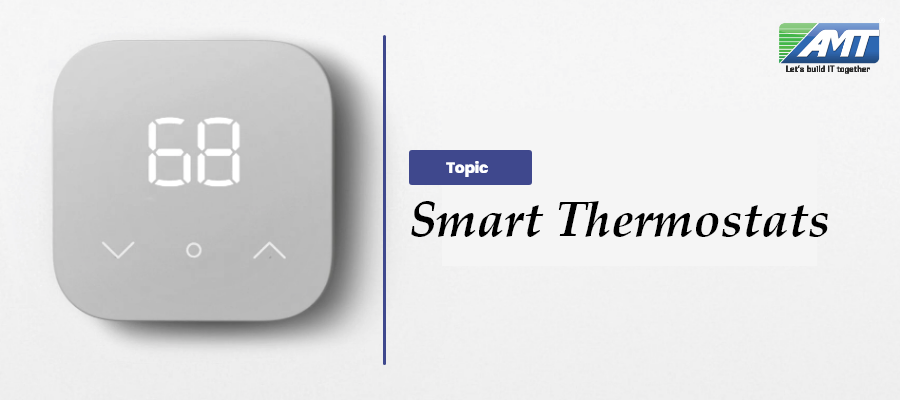Smart thermostats are thermostats that can be used with home automation and are responsible for controlling a home’s heating and/or air conditioning. They perform similar functions as a Programmable thermostat as they allow the user to control the temperature of their home throughout the day using a schedule, but also contain additional features, such as sensors and WiFi connectivity, that improve upon the issues with programmable thermostats.
Like a connected thermostat, they are connected to the Internet. They allow users to adjust heating settings from other internet-connected devices, such as a laptop or smartphones. This allows users to control the thermostat remotely. This ease of use is essential for ensuring energy savings: studies have shown that households with programmable thermostats actually have higher energy consumption than those with simple thermostats because residents program them incorrectly or disable them completely.
Smart thermostats also record internal/external temperatures, time the HVAC system has been running and can even notify you if your air filter needs to be replaced. This information is typically displayed later on an internet-connected device.
Manual thermostats:
Manual thermostats (also known as analog thermostats) are the oldest and simplest type of thermostats. These thermostats are set to one temperature and do not change until the user manually adjusts the temperature.
Programmable Thermostats:
Programmable thermostats, first introduced in the 1970s, are a type of thermostat that allows the user to set a schedule for different temperatures at different times. Most programmable thermostats also have a hold feature which suspends the schedule and effectively turns the thermostat into a manual thermostat. The idea of the scheduling feature is that users will set a warmer or cooler temperature when the home is unoccupied to save energy and money. Due to this assumed energy savings, some building codes and government programs began requiring the use of programmable thermostats. Unfortunately, due to human error in using these devices, many programmable thermostats result in more energy use than the basic manual thermostat.
One of the main objectives of smart thermostats is to reduce the issues involved with using traditional programmable thermostats. In order to understand how smart thermostats take on this task, it is important to understand the issues regarding programmable thermostats and how they affect energy consumption. Between 2008-2009, Florida Power & Light (FPL) provided 400 homeowners with programmable thermostats and monitored their heating and cooling patterns. Out of the 400 participants, 56% of users used the programming feature while the remaining participants did not program the thermostat and left it on “hold”. It was determined that the users who used the programming feature actually consumed 12% more energy than the non-programmers. This consumption increase resulted from higher overnight duty cycles associated with lower thermostat setpoints (i.e. lower temperature setting), due to confusion with setting the schedule. This study reveals that programmable thermostats will not necessarily save energy. The smart thermostat attempts to combat this issue by taking the user out of the picture and relying on sensors and computers to save energy.
Another study conducted on the issue determined that the biggest problem for programmable thermostats was the human using it. The technology inside a programmable thermostat is no doubt one of the most important factors in determining whether or not the thermostat will be successful in saving energy. But an equally important factor is the human who is using the thermostat. Unfortunately, many people who own programmable thermostats do not know how to use the thermostat or are not using all of the features that are offered. One study conducted a number of interviews, surveys, and observations to determine that the vast majority of programmable thermostat owners are not using the thermostats for their intended purpose. An online survey showed that 89% of respondents do not use the schedule feature on their programmable thermostat. Other results from the interviews and surveys show that a large number of people have misconceptions about heating/cooling and the use of programmable thermostats. One misconception is people believing that heating all of the time is more efficient than scheduling the heat to turn off. Another misconception noted in the study is that turning down the thermostat does not substantially reduce energy consumption. These misconceptions reaffirm the idea that the programmable thermostat itself could have all of the necessary tools, but if the user does not use them or uses them incorrectly, then these thermostats will fail at saving energy.
As a result of these studies and others like them, energy star suspended its labelling of programmable thermostats in December 2009. It became the goal of smart thermostats to address these issues by taking the human out of the picture and creating a thermostat that uses smart computing to truly reduce energy usage and cost.
Smart Thermostats:
Smart thermostats are similar to programmable thermostats in the sense that they have a scheduling feature that allows users to set different temperatures for different times of the day. In addition to this feature, smart thermostats implement other technologies to reduce the amount of human error involved with using programmable thermostats. Smart thermostats incorporate the use of sensors that determine whether or not the home is occupied and can suspend heating or cooling until the occupant returns. Additionally, smart thermostats utilize Wi-Fi connectivity to give the user access to the thermostat at all times. These additional technologies have proven to make smart thermostats successful in saving users energy and money.
The above is a brief about Smart thermostats. Watch this space for more updates on the latest trends in Technology.
